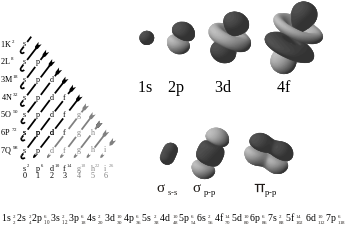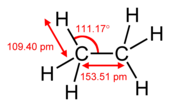Pi bond

In chemistry, a pi bond (

The Greek letter
Pi bonds are usually weaker than sigma bonds. Quantum mechanics says this is because the orbital paths are parallel so there is much less overlap between the p-orbitals.
Pi bonds happen when two atomic orbitals are in contact through two areas of overlap. Pi-bonds are more spread out bonds than the sigma bonds. Electrons in pi bonds are sometimes called pi electrons. Molecular fragments joined by a pi bond cannot rotate about that bond without breaking the pi bond. The rotation destroys the parallel paths of the two p orbitals.[2]
Multiple bonds
[change | change source]Atoms that are joined by a double bond have one sigma bond and one pi bond. If they are joined by a triple bond they have one sigma bond and two pi bonds.
A pi bond is weaker than a sigma bond, but the combination of pi and sigma bond is stronger than either bond by itself. The extra strength of a multiple bond versus a single (sigma bond) is shown in many ways. The most obvious is a contraction in bond lengths. For example in organic chemistry, carbon-carbon bond lengths are in ethane (154 pm), in ethylene (134 pm) and in acetylene (120 pm). More bonds make the total bond shorter and stronger. Electronic configuration is based on S,P,D,and f -Block. S has 2 electrons P has 6 electrons D has 10 electrons F has 14 electrons
 |
 |
 |
| ethane | ethylene | acetylene |
Special cases
[change | change source]Pi bonds do not necessarily join a pair of atoms that are also sigma-bonded.
In certain metal complexes, pi interactions between a metal atom and alkyne and alkene pi antibonding orbitals form pi-bonds.
In some cases of multiple bonds between two atoms, there is no sigma bond at all, only pi bonds. Examples include diiron hexacarbonyl (Fe2(CO)6), dicarbon (C2) and the borane B2H2. In these compounds the central bond has only pi bonding. In order to get the most orbital overlap the bond distances are much shorter than expected.



